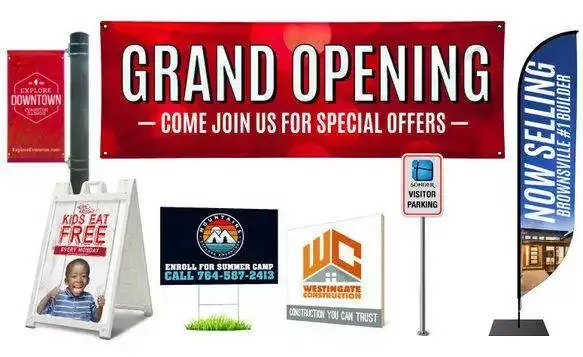In a world where first impressions are everything, business signs play a pivotal role in capturing attention and conveying messages succinctly. They serve as silent ambassadors of a brand, guiding potential customers toward products and services while simultaneously establishing an identity. But not all signs are created equal; they come in a myriad of shapes, sizes, and styles, each designed to fulfill unique purposes and engage diverse audiences. From the classic allure of illuminated marquee signage to the subtle elegance of vinyl decals, the types of business signs are as varied as the enterprises they represent. In this article, we will explore the different types of business signs, examining their functions, benefits, and ideal applications in the ever-evolving landscape of commerce. Join us as we navigate the fascinating world of visual communication and discover how businesses can effectively stand out in a crowded marketplace.

Exploring the Spectrum of Business Signage Options
When it comes to attracting customers and conveying your brand message, the right type of business signage plays a critical role. Businesses have a wide range of options to choose from, each serving unique purposes and ensuring that your message reaches your intended audience. Some popular signage options include illuminated signs, which are designed to stand out even in the nighttime, and banners, which are perfect for temporary promotions or events. You might also consider pylon signs, which offer high visibility from a distance, or digital signs, enabling you to display dynamic content and capture attention effectively.
Beyond these traditional formats, there are also more specialized signage options to further enhance your branding. For example, wall murals can transform your physical space into an immersive advertising platform, while window graphics can convert plain glass areas into eye-catching displays. A-frame signs are great for sidewalk advertising, attracting walk-in traffic. To help visualize the range of options, consider the table below:
| Sign Type | Best For | Key Benefit |
|---|---|---|
| Illuminated Signs | Nighttime Visibility | High Impact |
| Banners | Temporary Promotions | Cost-Effective |
| Pylon Signs | High Traffic Areas | Long-Range Visibility |
| Digital Signs | Dynamic Advertising | Versatility and Engagement |
| Wall Murals | Brand Storytelling | Unique Visual Appeal |

Key Characteristics and Benefits of Outdoor vs. Indoor Signs
When considering signage for your business, outdoor and indoor signs each offer distinct characteristics that cater to different needs. Outdoor signs are typically designed to withstand various weather conditions, using durable materials like aluminum and treated wood. These signs are often larger and include vibrant colors and bold designs to attract attention from a distance. Common features of outdoor signs include:
- Weather-resistant coatings to prevent fading and corrosion
- Illumination options, such as LED lighting for visibility at night
- Ample space for branding elements like logos and taglines
In contrast, indoor signs prioritize versatility and subtlety, often focusing on enhancing the aesthetic of the interior space while providing essential information to customers or employees. Indoor signs are generally smaller, allowing for more intricate designs, and are frequently created from materials like acrylic, vinyl, or wood finishes. They often serve functional purposes, such as wayfinding and informational signage. Key characteristics of indoor signs include:
- Customization options for unique branding needs
- Variety in textures and finishes to match interior decor
- Easy installation and repositioning to adapt to layout changes
Effective Design Strategies for Impactful Business Signage
Creating effective business signage is essential to capture attention and convey your brand message clearly. To achieve this, focus on several key design strategies that enhance visibility and impact. Color choices play a significant role; vibrant colors can attract attention, while a cohesive palette reinforces your brand identity. Additionally, font selection is crucial; opt for easily readable typefaces that suit your brand’s personality. Contrast between text and background will ensure readability from a distance, making your signs stand out in a crowded environment.
Another important aspect is size and placement. Ensure that the dimensions of your signage are proportionate to the viewing distance—larger signs are more effective for high-traffic areas. Furthermore, consider incorporating lighting into your design. Well-lit signage can make your brand more visible after dark and adds a professional touch. Incorporating interactive elements, such as QR codes, can also engage customers and direct them to more information. Here’s a quick comparison of different signage options:
| Sign Type | Benefits |
|---|---|
| Awning Signs | Enhances visibility while providing shelter. |
| LED Signs | Attracts attention, flexible messaging options. |
| Directional Signs | Guides customers and enhances navigation. |
| Window Graphics | Utilizes window space for promotion and branding. |
Q&A
Q&A: What Are the Different Types of Business Signs?
Q1: What are business signs, and why are they important?
A1: Business signs are visual graphics that convey information about a company. They serve multiple purposes: attracting customers, providing directions, and promoting brand identity. A well-placed and designed sign can significantly enhance visibility, reinforce branding, and even influence consumer behavior.
Q2: What are the most common types of business signs?
A2: Business signs come in various forms, each designed to serve specific functions. Here are some of the most common types:
- Exterior Signs: These are installed outside the business and include storefront signs, banners, and window displays. They aim to attract foot traffic and create an inviting atmosphere.
- Interior Signs: Found within the premises, these signs include directional signs, menu boards, and promotional displays, providing essential information to customers and enhancing their experience.
- Sidewalk Signs: Often seen on busy streets, these portable signs can be moved easily to catch the eye of passersby. Examples include A-frame signs and chalkboards, perfect for promoting daily specials.
- Digital Signs: Utilizing LED or LCD technology, digital signs can display dynamic content, making them highly effective for advertising promotions or events in real-time.
- Vehicle Wraps: By turning vehicles into mobile advertisements, businesses can reach a broader audience. These wraps can carry the company logo, contact information, and promotional messages.
- Neon and LED Signs: Known for their brightness and visibility, neon and LED signs are effective in attracting attention, particularly at night, making them a popular choice for bars, restaurants, and entertainment venues.
- Posters and Banners: Affordable and versatile, these signs can be employed for temporary promotions or seasonal sales, allowing businesses to adapt quickly to changing marketing strategies.
Q3: How do businesses decide which type of sign to use?
A3: The choice of sign typically hinges on several factors, including location, target audience, branding goals, and budget. A business located in a bustling urban area might opt for a large exterior sign or digital display to stand out among the competition, while a boutique might prefer smaller, elegant indoor signage to create a cozy atmosphere. Conducting market research and analyzing foot traffic patterns can further guide this decision-making process.
Q4: What role does local signage regulation play in sign selection?
A4: Local signage regulations can significantly influence the type and size of signs businesses can use. Zoning laws often dictate where signs can be placed, their height, and dimensions, as well as illumination requirements. Businesses should consult local ordinances before finalizing their signage plans to ensure compliance and avoid potential fines or forced alterations.
Q5: How can businesses ensure their signs are effective?
A5: To maximize effectiveness, businesses should focus on clarity, visibility, and brand consistency. Signs should be easily readable from a distance and convey the intended message quickly. Additionally, using consistent colors, fonts, and logos helps to reinforce brand identity. Lastly, strategic placement is crucial; signs should be positioned where they are most likely to be seen by the target audience, whether that’s on the storefront, within a shopping plaza, or alongside a busy road.
Q6: Are there any emerging trends in business signage?
A6: Yes! Innovations in technology and design are shaping new trends in business signage. Sustainability is gaining traction, with many businesses opting for eco-friendly materials. Interactive signs, such as QR codes and augmented reality features, are also becoming popular, allowing customers to engage directly with the brand. As consumer preferences evolve, businesses that embrace these trends can create dynamic and memorable signage that resonates with their audience.
—
the world of business signs is diverse and continually evolving. By understanding the various types and their implications, businesses can make informed decisions that bolster their visibility and connection with customers.
Key Takeaways
the world of business signage is as diverse as the businesses themselves. From the illuminating glow of neon signs to the subtle elegance of directional signage, each type serves a unique purpose and communicates a distinct message. As you navigate this vibrant landscape, consider the needs of your audience, the essence of your brand, and the impression you wish to leave. Whether you’re drawing in foot traffic, guiding customers within your establishment, or building brand identity, the right sign can make all the difference. Armed with the knowledge of these various types of business signs, you are now prepared to enhance your visibility and create a lasting impact in your community. Remember, a well-chosen sign is more than just a marker; it’s an opportunity to tell your story and welcome customers into your world. Happy signing!

